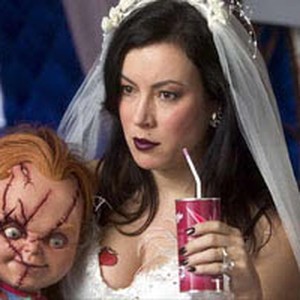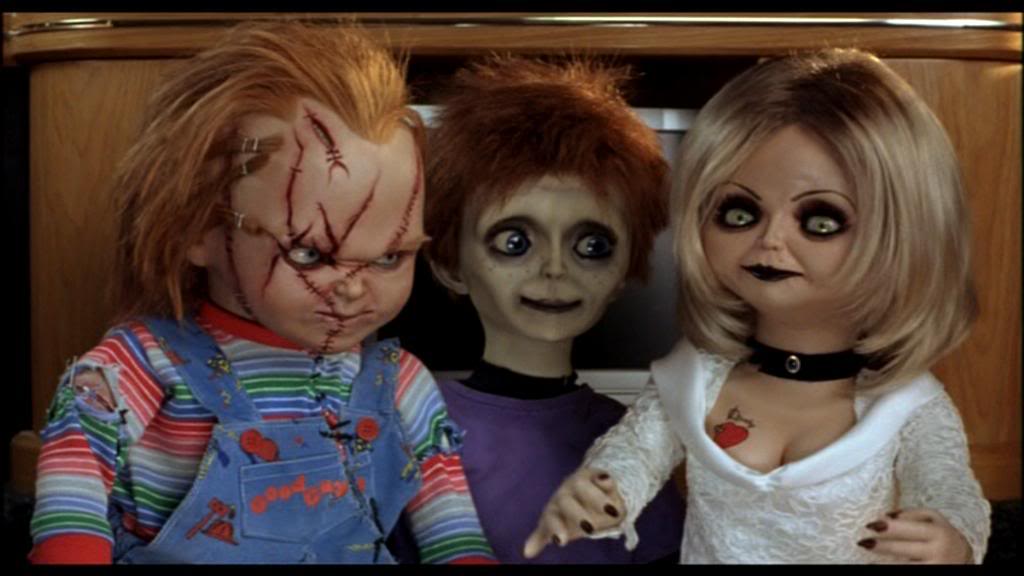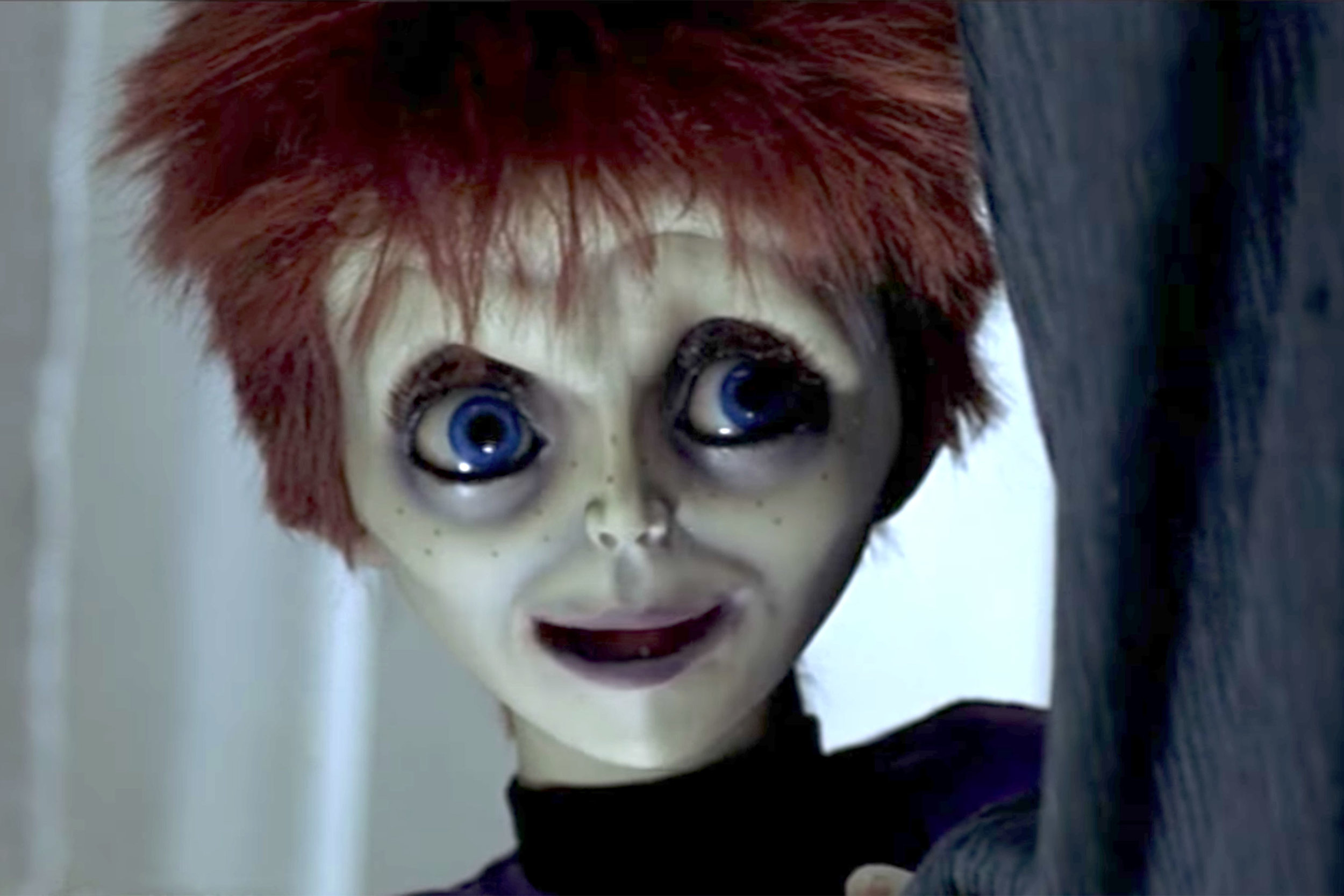Brad Dourif Month Continues With a Loving Look Back at 2004's Seed of Chucky
The Child’s Play franchise may not be the greatest or most important in horror history, but it just might be the most unpredictable and overachieving. 1988’s Child’s Play was far scarier than a horror movie whose bad guy is a smirking little hunk of plastic had any right to be. The surprise hit’s first two sequels followed a similarly straightforward path before 1998’s Bride of Chucky plugged into the post-Scream mania for post-modern deconstructionist horror satires with a sharp left turn into campy comedy.
Child’s Play was surprisingly scary because it somehow managed to avoid the camp and comedic elements at its core. 2004’s Seed of Chucky, in sharp contrast, is surprisingly funny and satirical precisely because it elevates the camp and comedic elements at the core of Child’s Play to ridiculous extremes.
You couldn’t really go any further than Seed of Chucky from a comic perspective, so unsurprising that the next film in the series, 2013’s direct-to-video Curse of Chucky represented a back-to-basics return to horror, this time in the form of a haunted house horror movie starring Fiona Dourif, the daughter of Brad Dourif, the voice of Chucky and the actor who played Charles Lee Ray, the serial killer whose spirit inhabits Chucky.
That means that 2004’s Seed of Chucky is all about Dourif’s Chucky learning to be a dad to his onscreen progeny, while Curse of Chucky is all about Dourif’s Chucky menacing the actor’s real-life daughter onscreen. Needless to say, for the Dourifs, this is a very strange, if lucrative, family business.
How crazy is Seed of Chucky? Let’s just say that there’s a sequence where a slimeball paparazzo played by John Waters (whose presence here feels like a benediction from the high priest of camp) diligently clicks away in astonishment and delight while killer doll Chucky masturbates feverishly into a cup as part of a ritual that’s half old-school artificial insemination and half old-school demonic voodoo possession. That sequence is probably only the thirteenth craziest and most outlandish element of the film.
In its bid to scare, rather than amuse audiences, Child’s Play understandably didn’t delve too deeply into questions like, “Can evil dolls have sex?”, “Do evil dolls have sperm?”, “What about urine? If nervous, could an evil doll piss itself?, “Can evil dolls reproduce, or are they made in evil factories alongside other evil dolls?” and finally “What other surprising bodily fluids do evil dolls possess?”
Seed of Chucky, on the other hand, is almost conspicuously obsessed with the bodily fluids of the malevolent, plastic, and non-human. The film’s scatological obsessions begin with an opening sequence that follows evil doll sperm as they do their business, eventually resulting in the creation of an evil doll that bears the stamp “Made in Japan” even if it was conceived far from the Orient.
This nutball fourth sequel opens with a pair of fake-outs. In the first, we assume a doll’s eye perspective as a British family receives a hideously ugly doll for Christmas that then proceeds to brutally murder them all. This is a Child’s Play movie, of course, so it’s natural to suspect these opening kills are the work of Chucky and/or his murderous wife Tiffany. But we eventually learn that this bloodshed is nothing but a horrific nightmare from Glen, an evil doll that was born without genitalia but with a lingering sense of curiosity about both his parents and his/her origins.
As voiced by Billy Boyd of The Lord of the Rings fame, Glen, who is known alternately as Glen and Glenda before ultimately choosing to identify as male at the film’s close, gives the series something it has never had before: a sympathetic killer. With his shock of bright orange hair, bone-white pallor, lanky physique and aggressive embrace of androgyny, Glen looks and acts more than a little like Ziggy Stardust-era David Bowie if Bowie were an unfortunate-looking, tragicomic doll that soils itself and twitches madly when nervous rather than a gender-bending outer space sex god. .
Like Norman Bates or Frankenstein’s Monster, Glen does not want to be bad. He does not want to kill. No, there is a gentleness and a vulnerability at the core of the character and Boyd’s surprisingly nuanced, powerful voice performance that comes through no matter how insane things get. The actors who voice Chucky and Tiffany have both been nominated for Oscars. I think we can all agree that Boyd was robbed of an Oscar nomination for his work here. It’s a real performance, and consequently Glen is a real character with real emotions and a real arc.
The second fake-out occurs halfway around the world, as a man in a Santa get-up talks to his girlfriend on the phone on Christmas Eve just long enough for his girlfriend to break up with him. Just when it seems like his day can’t get any worse, he’s brutally murdered by Chucky and Tiffany. This, also, is not what it appears to be. When “Chucky” keeps repeated the same phrase repeatedly, it’s revealed that we’re on the set of a horror movie loosely inspired by the “urban legend” of Chucky and Tiffany. “Chucky” is a mechanized puppet, film prop, before he inevitably becomes something much more real and sinister.
This kicks off the gonzo inside-Hollywood comedy aspect of the movie. I suspect that Seed of Chucky would have done better financially had it been released in 1998, when it could have rode the Scream wave of movie-mad meta bloodbaths to boffo box-office. By 2004, that wave had crashed and this kind of funhouse mirror treatment of horror’s past had fallen out of favor with critics and audiences.
Which is a shame, because Seed of Chucky succeeds through excess. It’s not the first movie to chase big, tasteless laughs out of the intersection of real life and reel life bloodshed, but no other movie could top it for shamelessness or audacity. So after Glen murders his owner/tormentor he makes like countless big-eyed show-business dreamers throughout the decades and heads to Hollywood to realize his destiny.
In Hollywood, the confused doll ends up bringing Chucky and Tiffany back to life and is overjoyed to discover that they’re his parents. As stated earlier, Chucky and Tiffany’s child does not have genitalia, which normally would not be an issue, but this is Seed of Chucky we’re talking about, so gender fluidity and confusion aren’t just explored: they’re pretty much central. This is less a “killer doll” movie than a “campy comedy of gender fluidity.” One is a little more commercial and genre-friendly than the other.
Seed of Chucky is seemingly more concerned with gender fluidity than it is in horror. Glen confides to his parents that sometimes he feels like a boy and sometimes he feels like a girl. The central conflict in the movie, consequently, is the battle between Chucky and Tiffany for Glen’s soul as well as his gender.
Jennifer Tilly returns as both the voice and soul of Tiffany and as herself. Tilly delivers a boldly, brazenly unselfconscious performance. Taking self-deprecation to its breaking point and beyond, Tilly portrays herself as a candy-hiding, wildly unethical striver more than willing to sleep with a director to get a role, even if the director is Redman (playing himself, of course, because this is Seed of Chucky) and the role is the Virgin Mary.
Chucky and Tiffany decide to become human by occupying the souls of Jennifer Tilly and Redman through demonic possession. Chucky wants his progeny to follow in his footsteps and join the family business of mass murder but Tiffany decides that she and her husband are addicted to killing, and pursues a 12 step program in a subplot that plays like a sly, incisive parody of Alcoholics Anonymous and less famous addiction treatment programs.
In the midst of all this cartoonish ridiculousness, Seed of Chucky somehow still manages to make us care about Glen’s immortal, albeit plastic soul. When Glen finally goes over to the dark side and begins to take after his folks, it’s both a little shocking and surprisingly poignant. Glen/Glenda is every bit as iconic and unforgettable as his parents, if infinitely more sympathetic and likable, but while Chucky and Tiffany are both horror icons, Glen, sexually and morally confused doll progeny of deranged mass murderers, remains a little too strange and unique to be accepted on a large scale, either within the world of Seed of Chucky or outside of it.
In Child’s Play, Chucky was a figure of pure fright. He was a scary monster but by Seed of Chucky he is a more or less purely comic figure. For the Nightmare on Elm Street franchise, turning a scary monster into a figure of fun ruined the scares. That strategy proves a lot more effective here, in no small part because Seed of Chucky isn’t particularly interested in being scary. So there’s not really a concern that the substantive amount of time the film devotes to Chucky’s masturbatory habits will detract from the horror.
In Child’s Play, Chucky was as existentially and literally alone as any man or monster ever conceived. By Seed of Chucky, he’s become an amusingly domesticated figure, an unlikely and not terribly overjoyed family man who has to pretend to want to stop murdering people because the old ball and chain keeps nagging him to give up indiscriminate slaughter for the sake of setting a good example for their child.
Though he deliberately chooses not to be human, Chucky has never seemed more poignantly, unexpectedly human than he does here. I doubt audiences for Child’s Play ever imagined a sequel where Chucky would talk about probable erectile dysfunction as one of many reasons not to become a human being who ages and decays, but that’s exactly the kind of insane detail that makes Seed of Chucky such a demented delight.
There’s always been a lot of Jack Nicholson, who co-starred with Dourif in One Flew Over the Cuckoo’s Nest, netting them both Oscar nominations in the process (Nicholson won, of course) in Chucky. This is particularly true of Seed of Chucky, where Chucky faces a dilemma not unlike that posed by Jack Torrance in The Shining: what do you do about the wife and kid when all you really want to do is murder people?
Chucky’s answer here is to kill with your child, so that murder doesn’t have to be something that inherently drives your family apart, but when Tiffany sees her offspring for the first time, her heretofore-unseen maternal side comes to the fore and her life and goals change almost instantly. She’s a lunatic with a conscience and a desire to do better for her child and her family but homicide is just too deeply embedded in her DNA, or whatever the evil doll equivalent of DNA might be, for her to abstain for too long. Tiffany eventually discovers that she’s just as incapable of following a lawful, moral path as her husband.
In true post-Scream form, Seed of Chucky doesn’t just revolve around the world of film, and some particularly desperate would-be players. It’s also filled with allusions to horror history, including the inevitable moment when, in a pitch-perfect recreation of the “Here’s Johnny” scene from The Shining, a rage-filled Chucky chops open a hole in a door in pursuit of his terrified wife and son and, when he has both their attention and ours, freezes, and with just the right note of self-awareness, concedes, “I can’t thing of a thing to say!”
The line feels ironic, because Seed of Chucky, God bless it, knows exactly what it wants to say and expresses that vision as forcefully as possible. Looking back, it’s not terribly surprising that this particular vision appealed to a narrower, more niche audience than the films that came before it.
I didn’t think much of Seed of Chucky when I reviewed it upon its initial release. The younger me dismissed Seed of Chucky for being so silly and ridiculous and over-the-top. Now that I am older and wiser and also dumber, I celebrate it for being so silly and ridiculous and over-the-top. It’s amazing Chucky ever scared anyone in the first place. Nearly three decades on, however, the series has over-achieved not just in terms of horror but also in laughs and straight-up weirdness.
Nathan needed expensive, life-saving dental implants, and his dental plan doesn’t cover them, so he started a GoFundMe at https://www.gofundme.com/f/support-nathans-journey-to-dental-implants. Give if you can!









